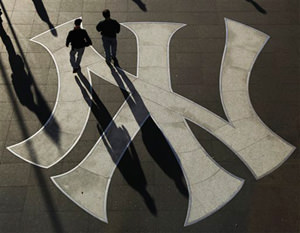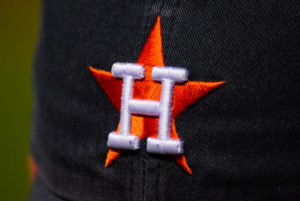How Baseball Became America vs. the Damn Yankees
Baseball has always proceeded according to the law of the jungle with the Yankees as King Kong, but in the past even they never dominated financially as they do now.
Go, Red Sox-er, Rays!
For me, the baseball season is a nine-month campaign to find someone who can beat the Yankees, a feeling as American as apple pie, or, as Chicago Tribune columnist Mike Royko once put it, “as American as pizza pie, unwed mothers, and cheating on your income tax.”
The comedian Joe E. Lewis said that rooting for the Yankees “is like rooting for U.S. Steel.” Columnist Jimmy Cannon — who was from New York — said it was “like owning a yacht.”
And that was before George Steinbrenner, when the Yankees were merely smug about using their superior resources to take Babe Ruth from the Red Sox and anyone they wanted from the Kansas City A’s.
Then came the loud, pathetically attention-seeking but undeniably canny Steinbrenner, who built them into such a financial behemoth that his loud, no more gracious and totally inexperienced son, Hank, could assume operational control in 2009 without missing a beat.
In familiar style, the new Boss, same as the old Boss, forced out Joe Torre — the manager who had put a human face on the organization while winning its only four championships in 20 years, but none since 2000 — hired Joe Girardi and went right back into the winner’s circle.
Sneered Hank, to the delight of the New York tabloids when Torre dared to express his disappointment: “Where was Joe’s career in ’95 when my dad hired him?”
Of course, a kid off the street, which was what Hank was, could run a team with experienced, if long-suffering, executives like Brian Cashman … not to mention a $201 million payroll in 2009, $52 million more than the No. 2 Boston Red Sox.
In income distribution, modern baseball makes Ronald Reagan look like Vladimir Ilyich Lenin with a laughable disparity between the super-rich (Yankees), the rich with payrolls over $125 million (Red Sox, Cubs, Phillies, Mets), the well-off over $100 million (Tigers, White Sox, Angels), the middle class over $70 million (Giants, Twins, Cardinals, Dodgers, Astros, Braves, Rockies, Orioles, Brewers, Reds, Royals, Rays) and the rabble (Nationals, Indians, Diamondbacks, Marlins, Rangers, Athletics, Padres, Pirates).
Baseball has always proceeded according to the law of the jungle with the Yankees as King Kong, but in the past even they never dominated financially as they do now.
In 1996, when Torre’s underdogs came from 2-0 down to upset the Braves, their $58 million payroll was $10 million more than No. 2 Baltimore, a “somewhat reasonable” 19 percent gap, according to Torre and co-writer Tom Verducci in their book, “The Yankee Years.”
In 2009, with the Yankees in a new stadium, making $100 million-plus in rights fees and profits from the YES cable network, the gap was a somewhat obscene 34 percent.
As sportswriter Joe Posnanski notes, the Yankees have underachieved on the field, with payrolls worth $1.9 billion over the last 10 years.
Happily for the game, it isn’t so easy to predict that spending equals success. If you don’t believe it, check out the top five National League hitters as of May 17:
1. Andre Ethier, Los Angeles: .392
2. Marlon Byrd, Chicago: .345
3. Ryan Braun, Milwaukee: .343
4. Andrew McCutchen, Pittsburgh: .340
5. Jayson Werth, Philadelphia: .333
Unhappily, for every franchise like Minnesota, which makes the playoffs regularly with payrolls in the $70-80 million range (if only because it’s in the low-wattage AL Central and still hasn’t been past the first round in 18 years), there are more like Kansas City (no postseason appearance in 24 years) and Pittsburgh (17 years), where the season is over before it starts — meaning it never really starts.
Or, maybe your idea of fun is thinking along with Oakland’s Billy Beane, the star of Michael Lewis’ “Moneyball,” a book about an allegedly slick young GM who cheats a system set up for the rich.
It’s true, the A’s made the playoffs … for one round, anyway … in the sleepy AL West, in 2000, 2001, 2002, 2003 and 2006.
Unfortunately, the system has since struck back, with the A’s winning only 76, 75 and 75 games the last three seasons, which is what happens when you have to turn loose Jason Giambi, Miguel Tejada, Johnny Damon, Barry Zito, Tim Hudson, et al., as soon as they’re eligible for free agency.
Nobody in baseball, not even small-market owners and GMs, says much about this tilted playing field anymore, as if they’re all frogs in a pot that had the heat turned up under them incrementally until they boiled.
The new apologia is the statistic showing nine teams competing in the last five World Series out of a possible 10.
That, of course, has as much to do with the modern postseason, which has three rounds, compared to the one the Yankees played while winning their first 20 World Championships, between 1923 and 1962.
Under the old system, the Yankees would have played in seven of the last 12 World Series, and the playing field wouldn’t look flat at all, as it isn’t in real life.
I’m a former baseball writer (Phillies backup, 1972-78, Angels, 1979, Dodgers, 1981-83) who still loves the game enough to pay to see it, which is as good as it gets for a sportswriter, especially at these prices ($100 for tickets, parking, hot dog, Coke and souvenir the last time I took my daughter).In the park, baseball has an epic feel all its own as 95-mph fastballs smack into the catcher mitts and home runs arc into the stands in majestic parabolas that make the world they left behind seem tiny.
As a competitive system, however, it’s like China in the warlord era, a tumultuous world with no order or balance.
A salary cap, like that of the NFL, NBA or NHL, would change everything, but, rising up before the owners like the Himalayas, is the Major League Baseball Players Association, which has effectively run things since it shut down the 1994 World Series and likes things the high-priced, unbalanced way they are.
“The Lords of Baseball,” as Dick Young once called the owners, were so offended by the union’s mere existence they warred on it at every opportunity, resulting in a shameful eight work stoppages between 1970 and 1994.
Instead of breaking the union, they turned it into a superb fighting force with a garrison mentality that would never again be inclined to give an inch on anything.
In 1994, the owners launched the all-out war they’d been spoiling for.
The broken lords of baseball, lowercase, have barely been heard from since.
The owners lined up behind amiable Bud Selig, the commissioner they chose from among their own — he owned the Milwaukee Brewers, which had a .500 season or two under him — to make sure they got no more advice they didn’t want to hear from the outsiders they had brought in, like Peter Ueberroth and Faye Vincent.
Showing what a doofus he was, Selig let the 1994 season start without a new bargaining agreement, rather than locking the players out.
In August the players, having banked most of their salaries with growing leverage as the postseason approached, struck.
The owners called their bluff. The postseason was lost. Dire things were said about the game’s future.
The owners got set to play 1995 with replacement players, but caved in after spring training with the wannabes and after federal Judge Sonia Sotomayor’s decision on an National Labor Relations Board petition raised the specter of triple damages in an antitrust action.
“We’re back and we’re delighted,” announced Selig, glossing over the fact they not only hadn’t gained anything, they didn’t even have a contract, in a lasting lesson for labor negotiations.
It’s now such a given that you don’t start a season without an agreement that people talk about the 2011 NFL and NBA lockouts as if they’ve already been announced.
It’s a cunning capitalist, or monopolist, indeed, who understands his interests lie with those of the proletariat — like George Steinbrenner, the Great Shop Steward, selling out his own “side” in a tacit alliance with the union to protect the status quo they all had reason to defend.
So, baseball looks like it’s good for another decade or two, to see if what’s good for the Yankees is good for the game, diving TV ratings notwithstanding.
In the meantime, it’s depressing to spend a whole season waiting to see who the Yankees get in the playoffs as they flatten everything in their way and cherry-pick poor teams’ too-costly player at the midseason fire sale if they’re short here or there.
On the other hand, having 29 teams to root for makes it fair, with one of them prevailing in nine of the last 14 years!
Even if you have to wait until fall, who says hope doesn’t still spring eternal?
Your support matters…Independent journalism is under threat and overshadowed by heavily funded mainstream media.
You can help level the playing field. Become a member.
Your tax-deductible contribution keeps us digging beneath the headlines to give you thought-provoking, investigative reporting and analysis that unearths what's really happening- without compromise.
Give today to support our courageous, independent journalists.





You need to be a supporter to comment.
There are currently no responses to this article.
Be the first to respond.